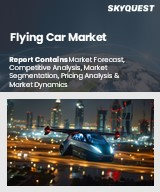
|
시장보고서
상품코드
1394602
세계의 플라잉카 시장 : 현황 분석 및 예측(2023-2030년)Flying Car Market: Current Analysis and Forecast (2023-2030) |
||||||
플라잉카(Flying Car) 시장은 투자 증가로 예측 기간 동안 53.4%의 강력한 CAGR로 추이하며 성장 할 것으로 예상됩니다. 예를 들어, 2020년 12월 Archer Aviation은 특별 목적 인수 회사(SPAC)와 합병하여 주식 공개를 위한 10억 달러의 거래를 발표했습니다. 이 회사는 2024년까지 전동 수직 이착륙기(eVTOL)를 출시할 예정입니다.
운용 모드에 따라 시장은 조종형과 자율형으로 이분됩니다. 2022년 시장에서는 조종 부문이 압도적인 점유율을 차지하고 있습니다. 플라잉카 시장에서 조종 부문은 여러 요인에 의해 견인됩니다. 첫째, 운송의 편의성과 효율성에 대한 요구가 증가하고 있습니다. 사람들은 이동 시간을 단축하고 교통 체증을 피하는 방법을 요구하고 있으며, 플라잉카는 이러한 과제를 극복할 가능성을 지니고 있습니다. 조종형 플라잉카는 공항이 필요없는 도어 투 도어 운송의 편의성을 제공하여 개인이 다른 장소를 쉽게 이동할 수 있도록합니다.
좌석수를 기준으로 시장은 2인승, 3인승, 4인승, 4인승 이상으로 구분됩니다. 2022년 시장에서는 2인승 카테고리가 압도적인 점유율을 차지하고 있습니다. 플라잉카 시장에서 2인승 부문 성장의 원동력 중 하나는 개인 운송 솔루션에 대한 수요 증가입니다. 혼잡한 도로, 긴 통근 시간, 제한된 주차 공간이 도시 지역에서 일반적인 문제가 되고 있기 때문에 개인은 교통 정체를 신속하게 통과할 수 있어 이동에 편리한 대체 교통 수단을 요구하고 있습니다. 2인승 플라잉카는 비행기와 자동차의 장점을 결합한 독특한 솔루션을 제공하여 기존의 교통 수단과 관련된 제한과 복잡성을 피하면서 개인이 빠르고 효율적으로 이동할 수 있도록 합니다.
플라잉카 시장 도입에 대한 이해를 높이기 위해 시장은 북미(미국, 캐나다, 기타 북미), 유럽(독일, 영국, 프랑스, 스페인, 이탈리아, 기타 유럽), 아시아 태평양(중국, 일본, 인도 및 기타 아시아 태평양) 및 기타 세계 국가에서 세계의 존재를 기반으로 분석됩니다. 2022년 시장 점유율은 북미가 압도적입니다. 수직 이착륙(VTOL) 차량으로도 알려진 플라잉카는 기존 자동차처럼 이착륙 및 이동이 가능하면서도 공중을 비행할 수도 있는 미래적인 차량입니다. 북미에서 플라잉카 시장의 성장에는 몇 가지 요인이 있습니다. 첫째, 기술의 발전과 보다 효율적인 교통수단에 대한 수요가 증가함에 따라 플라잉카의 발전을 뒷받침하고 있습니다. 도로 혼잡과 통근 시간이 증가함에 따라 플라잉카는 도시 지역의 교통 정체 문제에 대한 해결책을 제시합니다. 게다가 친환경 교통수단의 추진과 이산화탄소 배출량 감소의 필요성도 플라잉카에 대한 관심을 높여주고 있습니다. 이러한 자동차는 기존 자동차에 비해 연료 효율이 높고 온실가스 배출량도 적기 때문에 보다 지속가능하고 환경친화적인 자동차가 될 가능성이 있습니다.
목차
제1장 시장 소개
- 시장 정의
- 주요 목표
- 이해관계자
- 제한 사항
제2장 조사 방법 또는 전제
- 조사 과정
- 조사 방법
- 응답자 프로파일
제3장 시장 요약
제4장 주요 요약
제5장 세계의 플라잉카 시장에서 COVID-19의 영향
제6장 세계의 플라잉카 시장 수익(2020-2030년)
제7장 운용 모드별 시장 인사이트
- 조종형
- 자율형
제8장 좌석수별 시장 인사이트
- 2인승
- 3인승
- 4인승
- 4인승 이상
제9장 지역별 시장 인사이트
- 북미
- 미국
- 캐나다
- 기타 북미
- 유럽
- 독일
- 프랑스
- 영국
- 이탈리아
- 스페인
- 기타 유럽
- 아시아 태평양
- 중국
- 일본
- 인도
- 기타 아시아 태평양
- 세계의 기타 지역
제10장 플라잉카 시장 역학
- 시장 성장 촉진 요인
- 시장 과제
- 영향 분석
제11장 플라잉카 시장 기회
제12장 플라잉카 시장 동향
제13장 수요 및 공급측 분석
- 수요측 분석
- 공급측 분석
제14장 밸류체인 분석
제15장 경쟁 시나리오
- Porter's Five Forces 분석
- 경쟁 구도
제16장 기업 개요
- AeroMobil
- DELOREAN AEROSPACE, LLC
- Lilium GmbH
- Volocopter GmbH.
- EHang
- Joby Aviation
- Klein Vision, sro
- PAL-V
- Alef Aeronautics Inc
- Doroni.io
제17장 면책사항
LYJ 23.12.20The flying car market is a rapidly growing industry that aims to provide a new mode of transportation, combining the convenience of cars with the freedom of flight. Flying cars, also known as personal air vehicles (PAVs), promise to revolutionize urban transportation by alleviating road congestion and reducing travel time. The market for flying cars has garnered significant interest from both established companies and start-ups, with numerous players investing in research and development to bring these vehicles to market. Several automotive and aerospace giants, such as Airbus, Uber, and Boeing, have announced their foray into the flying car market, while startups like Terrafugia, Kitty Hawk, and Volocopter are also actively developing their protomode of Operations. The demand for flying cars arises from the increasing urbanization and population density in major cities. With limited road space and heavy traffic, flying cars offer a potential solution to these issues by utilizing the underutilized airspace. These vehicles are designed to take off and land vertically, requiring less infrastructure compared to conventional aircraft. Some models also feature hybrid capabilities, allowing them to drive on roads as well.
The Flying Car Market is expected to grow at a strong CAGR of 53.4% during the forecast period owing to increasing investments. For instance, In December 2020, Archer Aviation announced a $1 billion deal to merge with a special purpose acquisition company (SPAC) and go public. The company plans to launch its electric vertical takeoff and landing (eVTOL) aircraft by 2024.
Based on mode of operation, the market is bifurcated into piloted and autonomous. The piloted segment held dominant share of the market in 2022. The piloted segment in the flying car market is driven by several factors. Firstly, the demand for convenience and efficiency in transportation is increasing. People are looking for ways to reduce travel time and avoid traffic congestion, and flying cars offer the potential to overcome these challenges. Piloted flying cars provide the convenience of door-to-door transportation without the need for airports, allowing individuals to easily move between different locations.
Based on seating capacity, the market is segmented into 2 seater, 3 seater, 4 seater, and more than 4 seater. The 2 seater category held dominant share of the market in 2022. One of the driving factors for the growth of the 2-seater segment in the flying car market is the increasing demand for personal transportation solutions. With congested roads, long commutes, and limited parking spaces becoming a common issue in urban areas, individuals are looking for alternative modes of transport that can swiftly navigate through traffic and provide a convenient way to travel. The 2-seater flying cars offer a unique solution by combining the benefits of flying and driving, allowing individuals to travel quickly and efficiently while avoiding the limitations and complexities associated with traditional transportation modes.
For a better understanding of the market adoption of the flying car industry, the market is analyzed based on its worldwide presence in the countries such as North America (U.S., Canada, Rest of North America), Europe (Germany, U.K., France, Spain, Italy, Rest of Europe), Asia-Pacific (China, Japan, India, Rest of Asia-Pacific), Rest of World. North America held a dominant share of the market in 2022. Flying cars, also known as vertical takeoff and landing (VTOL) vehicles, are futuristic vehicles that have the capability to take off, land, and travel like traditional cars while also being able to fly in the air. There are several factors contributing to the growth of the North America flying car market. Firstly, advancements in technology and the increasing demand for more efficient transportation options are driving the development of flying cars. With congested roads and increasing commute times, flying cars present a solution to the problem of urban traffic congestion. Furthermore, the push for eco-friendly transportation and the need to reduce carbon emissions has also led to increased interest in flying cars. These vehicles have the potential to be more fuel-efficient and emit fewer greenhouse gases compared to traditional cars, making them more sustainable and environmentally friendly.
Some of the major players operating in the market include: AeroMobil; DELOREAN AEROSPACE, LLC; Lilium GmbH; Volocopter GmbH.; EHang; Joby Aviation; Klein Vision, s.r.o.; PAL-V; Alef Aeronautics Inc; and Doroni.io.
TABLE OF CONTENTS
1 MARKET INTRODUCTION
- 1.1. Market Definitions
- 1.2. Main Objective
- 1.3. Stakeholders
- 1.4. Limitation
2 RESEARCH METHODOLOGY OR ASSUMPTION
- 2.1. Research Process of the Flying Car Market
- 2.2. Research Methodology of the Flying Car Market
- 2.3. Respondent Profile
3 MARKET SYNOPSIS
4 EXECUTIVE SUMMARY
5 GLOBAL FLYING CAR MARKET COVID-19 IMPACT
6 GLOBAL FLYING CAR MARKET REVENUE, 2020-2030F
7 MARKET INSIGHTS BY MODE OF OPERATION
- 7.1. Piloted
- 7.2. Autonomous
8 MARKET INSIGHTS BY SEATING CAPACITY
- 8.1. 2 seater
- 8.2. 3 seater
- 8.3. 4 seater
- 8.4. More than 4 seater
9 MARKET INSIGHTS BY REGION
- 9.1. North America
- 9.1.1. US
- 9.1.2. Canada
- 9.1.3. Rest of North America
- 9.2. Europe
- 9.2.1. Germany
- 9.2.2. France
- 9.2.3. U.K.
- 9.2.4. Italy
- 9.2.5. Spain
- 9.2.6. Rest of Europe
- 9.3. Asia Pacific
- 9.3.1. China
- 9.3.2. Japan
- 9.3.3. India
- 9.3.4. Rest of Asia Pacific
- 9.4. Rest of World
10 FLYING CAR MARKET DYNAMICS
- 10.1. Market Drivers
- 10.2. Market Challenges
- 10.3. Impact Analysis
11 FLYING CAR MARKET OPPORTUNITIES
12 FLYING CAR MARKET TRENDS
13 DEMAND AND SUPPLY-SIDE ANALYSIS
- 13.1. Demand Side Analysis
- 13.2. Supply Side Analysis
14 VALUE CHAIN ANALYSIS
15 COMPETITIVE SCENARIO
- 15.1. Porter's Five Forces Analysis
- 15.2. Competitive Landscape
16 COMPANY PROFILED
- 16.1. AeroMobil
- 16.2. DELOREAN AEROSPACE, LLC
- 16.3. Lilium GmbH
- 16.4. Volocopter GmbH.
- 16.5. EHang
- 16.6. Joby Aviation
- 16.7. Klein Vision, s.r.o.
- 16.8. PAL-V
- 16.9. Alef Aeronautics Inc
- 16.10. Doroni.io
















